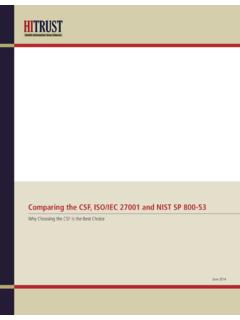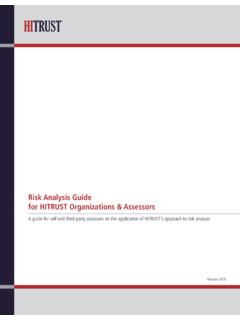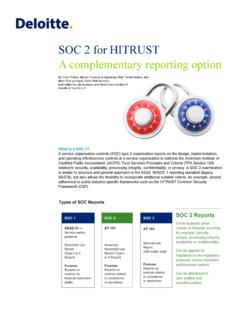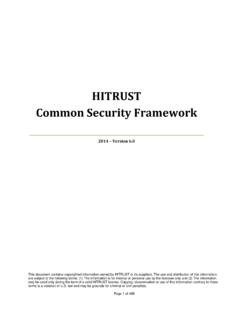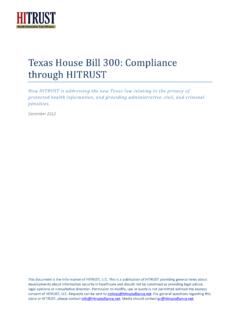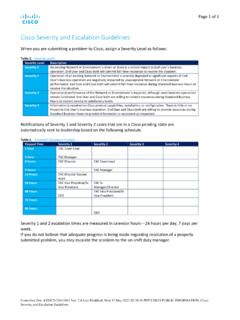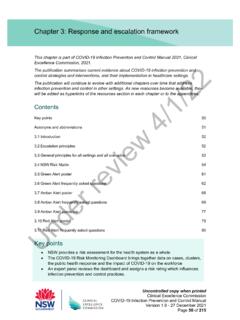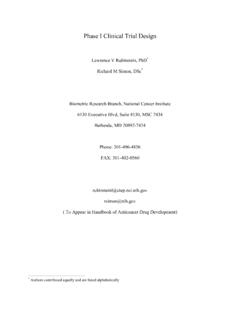Transcription of HITRUST Control Maturity Scoring Rubric (version 3)
1 HITRUST Control Maturity Scoring Rubric (version 3) HITRUST does not require that policy statements reside in only policy documents or that procedures reside in only procedure documents. They can reside in documents identified as standards, handbooks, guidelines, directives, etc. As specified in the policy illustrative procedures (r2 assessments) and/or evaluative elements (i1 assessments)Managed rating cannot exceed measured coverageRatingRangePoints AwardedNon-Compliant0% - 10%0% of points awardedSomewhat Compliant11% - 32%25% of points awardedPartially Compliant33% - 65%50% of points awardedMostly Compliant66% - 89%75% of points awardedFully Compliant90% -100%100% of points awarded 2022 HITRUSTA llrightsreserved. Anycommercialusesor creations of derivativeworks orutilizedotherthanbeingsharedasis in full, inanyform orby any means,electronical ormechanical,withoutHITRUST % of evaluative elements addressed by theorganization s procedure (Coverage)ProcedureStrengthVery Low0% - 10%Low11% - 32%Moderate33% - 65%High66% - 89%Very High90% - 100%Tier 2 Documented procedurePCMCFCTier 1 Undocumented procedureSCTier 0No procedureNCPOLICY % of evaluative elements addressed by theorganization s policy (Coverage)PolicyStrengthVery Low0% - 10%Low11% - 32%Moderate33% - 65%High66% - 89%Very High90% - 100%Tier 2 Documented policyPCMCFCTier 1 UndocumentedpolicySCTier 0No policyNCIMPLEMENTED% of evaluative elements implemented (Coverage)Implementation Strength(As a % of scope elements, , systems, facilities)
2 Very Low0% - 10%Low11% - 32%Moderate33% - 65%High66% - 89%Very High90% - 100%Tier 490% - 100% of scopeFCTier 366% - 89% of scopeMCTier 233% - 65% of scopePCTier 111% - 32% of scopeSCTier 00% - 10% of scopeNCFor varied or incomplete scope on each level, perform the following steps:Step 1) Decompose / separate scope into individual elements against which the Rubric can be applied Example: Two in-scope data centers (DC1,DC2) each use their own procedure for fire extinguisher maintenanceStep 2) Apply the HITRUST CSF Control Maturity Scoring Rubric to each individual scope element Example continued: DC1's procedure scoresas Mostly Compliant (75%) and DC2's procedure scores as Non-Compliant (0%)Step 3) Calculate an average score Example continued: (75% + 0%) / 2 = 4) Refer to the "Range of Averaged Scores" in the legend (right) to determine a rating Example continued.
3 Because falls within the range of 33% - 65%, the computed procedure rating is Partially CompliantLegendMANAGEDF requency of applying risk treatment(Coverage, as a % of issues identifiedfor the evaluative elements )Risk Treatment Process StrengthVery Low0% - 10%Low11% - 32%Moderate33% - 65%High66% - 89%Very High90% - 100%Tier 4 Documented with all formal risk treatment process criteria addressedFCTier 3 Documented with >1, but not all, formal risk treatment process criteria addressedMCTier 2 Documented with only 1 formal risk treatment process criterion addressedPCTier 1 Undocumented risk treatment processSCTier 0No risk treatment process OR measured score = NCNCMEASURED% of evaluative elements addressed by theorganization s measurement (Coverage)Measurement StrengthVery Low0% - 10%Low11% - 32%Moderate33% - 65%High66% - 89%Very High90% - 100%Tier 4 Measurement(s) used include an independent metricFCTier 3 Measurement(s) used include an operational metricMCTier 2 Measurement(s) used include an independent measurePCTier 1 Measurement(s) used include an operational measureSCTier 0No measurements usedNCUsed on both i1 and r2 s validated assessment fieldwork window (maximum)r2 and i1:90 calendar days from the start of the fieldwork period for the HITRUST validated assessment.
4 Minimum number of days that a remediated or newly implemented Control must operate prior to assessor testing ( , incubation period) 60 calendar days for a new or remediated policy or procedure 90 calendar days for a new or remediated Control at the implementation, measured and/or managed Maturity levelsMaximum age of testing performed by the organization ( , by an Internal Assessor) being relied upon by the external assessor90 calendar days, as determined by comparing the external assessor s fieldwork start date to the internal assessor s fieldwork start dateMaximum age of third-party assessments/inspections/audits being relied upon by the assessorOne year, as determined by comparing the HITRUST validated assessment fieldwork start date to: Period end date (for period-of-time reports) Final report date (for point-in -time reports or forward-looking certifications)Validity window for a HITRUST Certificationr2:Two years from HITRUST Certification date.
5 Requires completion of interim assessment at one-year :One year from HITRUST certification that an interim assessment can begin (or interim assessment object can be created in MyCSF)120 days before the one-year anniversary of the HITRUST Certification (based on the HITRUST Validated Report's date)Bridge certificate timing considerations Note: Bridge certificates are only available for r2 validated assessments with certification. Additional guidance on bridge certificates can be found at ( ) Bridge certificate is valid for 90 days after the expiration of the previous validated assessment. Object can be created in MyCSFup to 60 days prior to expiration of the previous certification s expiration. Bridge must be submitted no more than 30 days before and up to 30 days after the expiration date of previous intention and direction as formally expressed by management, most often articulated in documents that record high-level principles or course of actions; the intended purpose is to influence and guide both present and future decision making to be in line with the philosophy, objectives and strategic plans established by the enterprise s management teams.
6 [ISACA Glossary of Terms, adapted]A documented policymust specify the mandatory nature of the requirement statement in a written format which could reside in a document identified as a policy, standard, directive, handbook, etc. PROCEDUREA detailed description of the steps necessary to perform specific operations in conformance with applicable standards. Procedures are defined as part of processes.[ISACA Glossary of Terms, adapted]A documented proceduremust address the operational aspects of how to perform the requirement statement. The procedure should be at a sufficient level of detail to enable a knowledgeable and qualified individual to perform the supported by written proof.[Cambridge Dictionary]Undocumented policies and procedures are those that are:(i) well-understood by those required to implement them and / or adhere to them, (ii) consistently observed, and(iii) TREATMENTS electing and implementing mechanisms to modify risk.
7 Risk treatment options can include avoiding, optimizing, transferring, or retaining [accepting] risk.[ENISA Glossary of Terms]To be classified as a risk treatment process for HITRUST assessmentpurposes, the process must include:(i) initial involvement of an appropriate level of management or a defined escalation or review process to be observed if / when the appropriate level of management is not initially involved, (ii) a defined mechanism to track issues, risks, and risk treatment decisions, and (iii) cost, level of risk, and mission impact are considered in risk treatment results of data collection, analysis and reporting. [NIST CSRC Glossary of Terms]A standard used to evaluate and communicate performance against expected results (measures are normally quantitative in nature capturing numbers, dollars, percentages, etc., but can also address qualitative information such as customer satisfaction; reporting and monitoring measures help an organization gauge progress toward effective implementation of strategy).
8 [ISACA Glossary of Terms]A measure is a mechanism used to formally evaluate and communicate the operation / performance of an implemented Control or requirement. Measures are measurements that are prepared in real-time or at a set cadence ( , weekly, monthly, quarterly, annually) using a defined set of inputs ( , system-generated reports) by an understood / clearly defined owner. Examples of measurements in the context of the HITRUST Assurance program include information obtained from user access reviews, compliance checks, dashboards, alerts, health reports, and be classified as a measure for HITRUST assessment purposes, supporting documentation must:(i) address the Control s operation / performance,(ii) specify an appropriate frequency,(iii) define what is measured,(iv) identify who is responsible for gathering the data,(v) describe how the data is recorded, (vi) describe how the measurement is performed / calculated, and(vii) specify how often the measure is reviewed and by designed to facilitate decision making and improve performance and accountability through collection, analysis, and reporting of relevant performance-related data.
9 [NIST CSRC Glossary of Terms]A quantifiable entity that allows the measurement of the achievement of a process goal (metrics should be SMART specific, measurable, actionable, relevant, and timely; complete metric guidance defines the unit used, measurement frequency, ideal target value, if appropriate, and also the procedure to carry out the measurement and the procedure for the interpretation of the assessment).[ISACA Glossary of Terms]Measurements provide single-point-in -time views of specific, discrete factors, while metrics are derived by comparing to a predetermined baseline of two or more measurements taken over time. [Educause (2017, Mar). Effective Security Metrics: A guide to Effective Security Metrics]To be classified as metric for HITRUST assessment purposes, the measurement must meet ALL requirements for a measure (listed above) AND: (i) be tracked over time, and (ii) have explicitly stated (not implied), established thresholds ( , upper and/or lower bounds on a value) or targets ( , targeted goals, what the organization is trying to achieve).
10 Measurement ConceptsDefinition(s)GuidanceAUTOMATED CONTROLSC ontrols that have been programmed, configured, and/or embedded within a system.[ISACA Glossary of Terms, adapted]Automated controls are performed by systems not people based on configurations, rulesets, or programming. An example of an automated Control is forced password expiration after the number of days specified in the associated Key ConceptsDefinition(s)GuidanceSample-base d Testing RequirementsSampling ScenarioMinimum Number of Items to Test*Testing a manual Control operating at a defined frequencyThe expected frequency of the Control must first be defined and then apply the following minimum requirements: Daily controls: 25 days Weekly controls: 5 weeks Monthly controls: 2 months Quarterly controls: 2 quarters Semi-annual controls: 2 halves Annual controls: 1 year (most recent Control occurrence)Testing a manual Control operating at an undefined frequency ( , as needed )Sample size varies based on population size: Pop.
